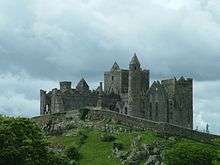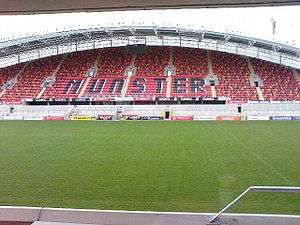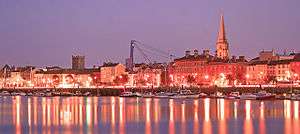Munster
| Munster An Mhumhain[1] | ||
|---|---|---|
| ||
 | ||
| Coordinates: 52°15′N 9°00′W / 52.25°N 9°WCoordinates: 52°15′N 9°00′W / 52.25°N 9°W | ||
| State |
| |
| Counties |
Clare Cork Kerry Limerick Tipperary Waterford | |
| Government | ||
| • Teachta Dálaí |
21 Fine Gael TDs 9 Labour Party TDs 7 Fianna Fáil TDs 5 Independent TDs 3 Sinn Féin TDs 1 ULA TD | |
| Area | ||
| • Total | 24,675 km2 (9,527 sq mi) | |
| Population (2011)[2] | ||
| • Total | 1,246,088 | |
| • Rank | 3rd in Ireland, 2nd in the Republic of Ireland | |
| ISO 3166 code | IE-M | |
| Patron Saint: Ailbe of Emly[3] | ||
Munster (Irish: an Mhumhain / Cúige Mumhan, pronounced [ə ˈvuːnʲ], [ˌkuːgʲə ˈmuːn]) is one of the provinces of Ireland situated in the south of Ireland. In early Ireland, it was one of the "fifths" ruled by a "king of over-kings" Irish: rí ruirech. Following the Norman invasion of Ireland, the ancient kingdoms were shired into counties for administrative and judicial purposes. In later centuries, local government legislation has seen further sub-division of the historic counties.
Munster has no official function for local government purposes. For the purposes of the ISO, the province is listed as one of the provincial sub-divisions of the State (ISO 3166-2:IE) and coded as "IE-M". Geographically, Munster covers a total area of 24,675 km2 (9,527 sq mi) and has a population of 1,246,088 with the most populated city being Cork. Other significant urban centres in the province include Limerick and Waterford.
History

In the early centuries AD, Munster was the domain of the Iverni peoples and the Clanna Dedad familial line, led by Cú Roí and to whom the king Conaire Mór also belonged. In the 5th century, Saint Patrick spent several years in the area and founded Christian churches and ordained priests. During the Early Middle Ages, most of the area was part of the Kingdom of Munster, ruled by the Eóganachta dynasty. Prior to this, the area was ruled by the Dáirine and Corcu Loígde overlords from the early 7th century onwards, perhaps beginning with the career of Faílbe Flann mac Áedo Duib. Later rulers from the Eóganachta who would dominate a greater part of Ireland were Cathal mac Finguine and Feidlimid mac Cremthanin. Notable regional kingdoms and lordships of Early Medieval Munster were Iarmuman (West Munster), Osraige (Ossory), Uí Liatháin, Uí Fidgenti, Éile, Múscraige, Ciarraige Luachra, Corcu Duibne, Corcu Baiscinn, and Déisi Muman. By the 9th century the Gaels had been joined by Norse Vikings who founded towns such as Cork, Waterford and Limerick, for the most part incorporated into a maritime empire by the Dynasty of Ivar, who periodically would threaten Munster with conquest in the next century. Around this period Ossory broke away from Munster. The 10th century saw the rise of the Dalcassian clan, who had earlier annexed Thomond, north of the River Shannon to Munster. Their leaders were the ancestors of the O'Brien dynasty and spawned Brian Boru, perhaps the most noted High King of Ireland, and several of whose descendants were also High Kings.
By 1118 Munster had fractured into the Kingdom of Thomond under the O'Briens, the Kingdom of Desmond under the MacCarthy dynasty (Eóganachta), and the short-lived Kingdom of Ormond under the O'Kennedys (another Dalcassian sept). The three crowns of the flag of Munster represent these three late kingdoms.
There was Norman influence from the 14th century, including by the FitzGerald, de Clare and Butler houses, two of whom carved out earldoms within the Lordship of Ireland, the Earls of Desmond eventually becoming independent potentates, while the Earls of Ormond remained closer to England. The O'Brien of Thomond and MacCarthy of Desmond surrendered and regranted sovereignty to the Tudors in 1543 and 1565, joining the Kingdom of Ireland. The impactful Desmond Rebellions, led by the FitzGeralds, soon followed.
By the mid-19th century much of the area was hit hard in the Great Famine, especially the west.[4] The province was affected by events in the Irish War of Independence in the early 20th century, and there was a brief Munster Republic during the Irish Civil War.
The Irish leaders Michael Collins and earlier Daniel O'Connell came from families of the old Gaelic Munster gentry.
Culture
Noted for its traditions in Irish folk music, and with many ancient castles and monasteries in the province, Munster is a tourist destination. During the fifth century, St. Patrick spent seven years founding churches and ordaining priests in Munster, but a fifth century bishop named Ailbe is the patron saint of Munster.
In Irish mythology, a number of pagan goddesses are associated with the province including Anann, Áine, Grian, Clíodhna, Aimend, Mór Muman, Bébinn, Aibell and Queen Mongfind. Each is historically associated with certain septs of the nobility. The druid-god of Munster is Mug Ruith.
The province has long had trading and cultural links with continental Europe. The tribe of Corcu Loígde had a trading fleet active along the French Atlantic coast, as far south as Gascony, importing wine to Munster. The Eóganachta had ecclesiastical ties with Germany, which show in the architecture of their ceremonial capital at the Rock of Cashel.
The majority of Irish ogham inscriptions are found in Munster, principally in areas occupied by the Iverni, especially the Corcu Duibne.[5] Later, Europe's first linguistic dictionary in any non-Classical language, the Sanas Cormaic, was compiled by Munster scholars, traditionally thought to have been directed by the king-bishop Cormac mac Cuilennáin (d. 908).
The School of Ross in Munster was one of Europe's leading centres of learning in the Early Middle Ages.
Sport
Several sports in Munster are organised on a provincial basis, or operate competitions along provincial lines. This includes traditionally popular sports such as hurling, Gaelic football, rugby union and soccer, as well as cricket (Munster Cricket Union), hockey (Munster Hockey Union), and others.
Hurling and football
Munster is noted for its tradition of hurling. Three of the four most successful teams in the All-Ireland Senior Hurling Championship are from Munster; Cork GAA, Tipperary GAA and Limerick GAA. The final of the Munster Senior Hurling Championship is one of the most important days in the Irish GAA calendar. Munster is the only province in Ireland that all of its counties have won an All-Ireland Senior Hurling Championship.
Traditionally, the dominant teams in Munster football are Kerry GAA and Cork GAA, although Tipperary GAA and Limerick GAA have also won All-Ireland Senior Football Championships. Kerry in particular are the most successful county in the history of football.
Rugby Union

Rugby is a popular game in the cities of Limerick and Cork. Munster Rugby is an Irish Rugby Football Union representative side which competes in the Pro12 competition, winning in 2003, 2009 and 2011 and in the Heineken Cup, winning in 2006 and 2008. Until 2016, the Munster side was the only Irish side to have defeated the New Zealand All Blacks.
Soccer
Association football is also a popular game in Munster, with the Munster Football Association governing a number of aspects of the game in the province. Four Munster clubs play in the Airtricity League of Ireland; Cork City F.C. and Limerick FC in the League of Ireland Premier Division and Waterford United & Cobh Ramblers in the Irish First Division.
Irish language
The Irish language, or more specifically Munster Irish, is spoken as a first language in Gaeltachtaí (Irish speaking areas) in a number of areas in the province. This includes West Kerry (Corca Dhuibhne), South Kerry (Uíbh Ráthach), West Cork (Múscraí), south-west Cork (Oileán Cléire), and parts of Waterford (Gaeltacht na Rinne or Gaeltacht na nDéise).
There are about 35,000 Irish language speakers in Munster, with 9,737 native speakers in the Munster Gaeltacht areas of Cork, Kerry and Waterford. There are also 12,219 pupils attending 46 Gaelscoils (Irish language primary schools) and 22 Gaelcholáiste (Irish language secondary schools) in the province. As of the Census of Ireland 2011 there were 13,193 daily speakers outside the education system in Munster.
Divisions
| Historical population | ||
|---|---|---|
| Year | Pop. | ±% |
| 1981 | 998,315 | — |
| 1986 | 1,020,577 | +2.2% |
| 1991 | 1,009,533 | −1.1% |
| 1996 | 1,033,903 | +2.4% |
| 2002 | 1,100,614 | +6.5% |
| 2006 | 1,173,340 | +6.6% |
| 2011 | 1,246,088 | +6.2% |
| [6] | ||
The province includes nine local government structures, made up of six counties and three cities:
| County/City | Population[7] | Area (km²) |
|---|---|---|
| County Clare | 117,196 | 3,450 |
| County Cork | 399,802 | 7,500 |
| Cork City | 198,582 | |
| County Kerry | 145,502 | 4,807 |
| County Limerick | 100,394 | 2,756 |
| Limerick City | 102,161 | |
| County Tipperary | 158,754 | 4,305 |
| County Waterford | 62,276 | 1,857 |
| Waterford City | 51,519 | |
| Total | 1,246,088 | 24,675 |
Urban areas
Munster has many large towns (including a number of growing satellite towns) and is the province with the most cites in the Republic of Ireland.


In order of size (2011 census figures; urban areas with over 10,000 inhabitants):
Urban areas 5,000–10,000
- Nenagh (9,891)
- Shannon (9,673)
- Dungarvan (9,427)
- Thurles (9,229)
- Youghal (8,192)
- Newcastle West (7,098)
- Fermoy (7,031)
- Carrigtwohill (6,665)
- Tipperary (6,510)
- Bandon (6,640)
- Carrick on Suir (6,387)
- Roscrea (6,318)
- Monkstown (6,129)
- Clonakilty (5,793)
- Listowel (5,772)
- Blarney (5,310)
- Mitchelstown (5,059)
Economy
Munster is the second wealthiest province on the island of Ireland, with 2012 Eurostat figures indicating GDP per capita ranges from €25,600 in the South Tipperary/Waterford (South-East) region to €48,500 in Cork and Kerry (South-West).[8] The province contributes 50bn euro to Irish GDP (25% of total Irish GDP in 2012).[9]
| Area | Population | Counties | City | GDP € | GDP per person € |
|---|---|---|---|---|---|
| South-West Region | 660,000 | Cork & Kerry | Cork | €32.3 bn | €48,500 |
| Mid-West Region | 380,000 | Limerick & North Tipperary & Clare | Limerick | €11.4 bn | €30,300 |
| South-East Region | 460,000 | Waterford & South Tipperary | Waterford | €12.8 bn | €25,600 |
| Source: Eurostat[10] | |||||
Employment
Large employers in the region include AOL, Bausch & Lomb, Dairygold, Dell, Amazon, Motorola, Amgen, Pfizer, Analog Devices, Fexco Financial Services, Vistakon, Waterford Crystal, Apple Computer, Intel, Novartis, O2, Lufthansa Technik, Kerry Group, Siemens, Sony and Blizzard Entertainment. The largest employment hub in Munster is Metropolitan Cork, with a number of multinational firms located in the Cork city area.
Media
A number of television companies and studios have (or had) a Munster-focus. These include RTÉ Cork (RTÉ's regional studio in Cork), South Coast TV and Channel South. The latter transmitted local programming to Cork, Limerick, and parts of Kerry, Waterford, Clare and Tipperary.
Apart from the local city or regional newspapers, a number of print outlets focus or market themselves on a provincial basis. These include the Avondhu (covering parts of Cork, Waterford, Limerick and Tipperary),[11] the Nationalist & Munster Advertiser, the Munster Express,[12] and others.
See also
References
- ↑ ISO 3166-2 Newsletter II-1, 19 February 2010, which gives "Munster" as the official English name of the Province and "An Mhumhain" as the official Irish name of the Province and cites "Ordnance Survey Office, Dublin 1993" as its source – http://www.iso.org/iso/iso_3166-2_newsletter_ii-1_corrected_2010-02-19.pdf
- ↑ "Province Munster". Central Statistics Office. 2011.
- ↑ Challoner, Richard. A Memorial of Ancient British Piety: or, a British Martyrology, p. 128. W. Needham, 1761. Retrieved 14 March 2013.
- ↑ In 1841, before the Great Famine, there were just under three million people living in the province, but the population dropped devastatingly low due to mass emigration in the 1840s and continued emigration up until the 1980s.
- ↑ The ruins of the Iron Age mountaintop fortress Caherconree, preserving the name of Cú Roí, can also be found in their lands.
- ↑ for post 1821 figures, 1653 and 1659 figures from Civil Survey Census of those years, Paper of Mr Hardinge to Royal Irish Academy March 14, 1865, For a discussion on the accuracy of pre-famine census returns see JJ Lee "On the accuracy of the pre-famine Irish censuses" in Irish Population, Economy and Society edited by JM Goldstrom and LA Clarkson (1981) p54, in and also New Developments in Irish Population History, 1700-1850 by Joel Mokyr and Cormac Ó Gráda in The Economic History Review, New Series, Vol. 37, No. 4 (Nov., 1984), pp. 473-488.
- ↑ CSO, Census 2011.
- ↑ County Dublin#cite note-7
- ↑ "County incomes and regional GDP" (PDF).
- ↑ http://appsso.eurostat.ec.europa.eu/nui/submitViewTableAction.do
- ↑ "About Us". AvondhuPress. Retrieved 2016-02-21.
- ↑ "About Us | Munster Express Online". Munster-express.ie. Retrieved 2016-02-21.
External links
| Wikimedia Commons has media related to Munster. |
- Gaeltacht Comprehensive Language Study 2007
- Gaelscoil stats
-
 Texts on Wikisource:
Texts on Wikisource:
- Rines, George Edwin, ed. (1920). "Munster". Encyclopedia Americana.
- "Munster (Ireland)". Encyclopædia Britannica (11th ed.). 1911.
- Gilman, D. C.; Thurston, H. T.; Colby, F. M., eds. (1905). "Munster". New International Encyclopedia (1st ed.). New York: Dodd, Mead.

